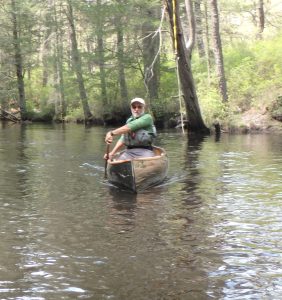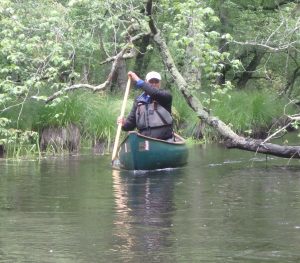by Marc Ornstein
One of the hallmarks of FreeStyle is efficiency and the conservation of your energy. The first step, in most cases, is to efficiently get the boat moving, forward or reverse. Several previous Cross Post articles have addressed that issue: https://freestylecanoeing.com/theres-always-a-catch/ and https://freestylecanoeing.com/full-speed-astern-part-1/ The energy that you expended, putting the canoe into motion is now transferred to the canoe as its momentum. Efficiently Maneuvering the canoe, once it is moving, is mostly a matter of redirecting that momentum.

All too often we see the use of inefficient methods, which though they manage to point the canoe in the desired direction, eat away much of its momentum requiring the paddler to expend more energy to get it going again. An example would be a poorly executed J stroke or stern rudder where the paddle is angled out too far, creating unnecessary turbulence and in effect putting on the brakes. Similarly, a powerful sweep creates substantial turbulence around the blade as well as around the bow and stern of the canoe. All that stirring of the water is wasteful of energy, your energy, that you used to get the boat moving.
Generally, it doesn’t require much energy to set a moving canoe on a new course. The trick, as it were, is to apply that energy gently, in as efficient a method as possible, redirecting the existing momentum. Instead of a sweep (to turn toward your off-side) try a gently applied wedge. The force of the water against the slightly angled blade will nudge the canoe in the desired direction with minimal loss of momentum and will conclude with the paddle well placed for the beginning of your next stroke.

Perhaps a side slip, drawing or prying, will get you where you need to be, without turning at all. (https://freestylecanoeing.com/solo-sideslips/) With an accurate placement of the paddle and the blade gently turned in (prying the canoe away from the paddle side) or out (drawing the canoe toward the paddle side) The hull will slide in the desired direction, with minimal turbulence and loss of momentum. These are but a couple of examples of how efficient maneuvers can conserve your momentum.
Proper use of heeling (https://freestylecanoeing.com/a-pitch-for-heeling-part-1/) increases the efficiency of all turns. I’m not referring to anything extreme, just a mild heel; enough to raise the stems a bit so they don’t have to plow so much water aside as the bow swings into the turn and the stern swings away from it. It takes minimal energy from you, the paddler, to drop a bit more weight onto one knee while slightly unweighting the other. Heeling toward the outside of the turn (carving) is a bit more efficient than heeling into the turn but the difference is minimal. Either is quite effective.
The key is to give your canoe gentle/subtle cues through efficient use and placement of the paddle. The sight or sound of significant turbulence near the stems of the hull or around the paddle are signs of wasted energy and loss of momentum.
I’ve included several links in this article. They will take you to more detailed explanations of the various maneuvers. There are many more articles about these and other efficient maneuvers at https://freestylecanoeing.com/blog/ .